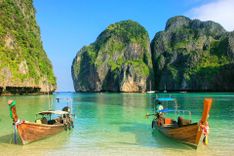For most visitors, the days are spent indulging in a few watersports or just lying on the beach waiting for the next drinks-seller, hair-braider or masseur to come along. For something more active, you should not miss the almost supernatural beauty of the Ang Thong National Marine Park, which comprises many of the eighty islands in the Samui archipelago. Otherwise, a day-trip by rented car or motorbike on the 50km round-island road, perhaps making time for a meal at the excellent Ban Hua Thanon Seafood on the south coast, will throw up plenty more fine beaches.
The island’s most appealing strand, Chaweng, has seen the heaviest, most crowded development and is now the most expensive place to stay, though it does offer by far the best range of amenities and nightlife, ranging from tawdry bar-beers to hip nightclubs. Its slightly smaller neighbour, Lamai, lags a little behind in terms of looks and top-end development, but retains large pockets of backpacker bungalow resorts. The other favourite for backpackers is Maenam, which, though less attractive again, is markedly quiet, with plenty of room to breathe between the beach and the round-island road. Adjacent Bophut is similar in appearance, but generally more sophisticated, with a cluster of boutique resorts, fine restaurants and a distinct Mediterranean feel in its congenial beachfront village. Choeng Mon, set apart in Samui’s northeast corner, offers something different again: the small, part-sandy, part-rocky bay is tranquil and pretty, the seafront between the handful of upmarket hotels is comparatively undeveloped, and Chaweng’s nightlife is within easy striking distance.
No particular season is best for coming to Ko Samui. The northeast monsoon blows heaviest in November, but can bring rain at any time between October and January, and sometimes causes high waves and strong currents, especially on the east coast. January is often breezy, March and April are very hot, and between May and October the southwest monsoon blows onto Samui’s west coast and causes some rain. Festivals include a week-long jazz festival in September (samuijazzfestival.com) and a six-day sailing regatta in May/June, with lots of attendant parties and festivities (samuiregatta.com). At the lower end of Samui’s accommodation scale, there are very few bungalows left for under B400, while at the most upmarket places you can pay well over B4000 for the highest international standards. The prices listed are based on high-season rates, but out of season (roughly April–June, Oct & Nov) dramatic reductions are possible.





